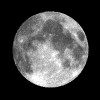
| Bad Astronomy |
|
|
|
BA Blog
|
|
Q & BA
|
|
Bulletin Board
|
| Media |
|
|
|
Bitesize Astronomy
|
|
Bad Astro Store
|
|
Mad Science
|
|
Fun Stuff
|
| Site Info |
|
|
|
Links
|
| RELATED SITES |
| - Universe Today |
| - APOD |
| - The Nine Planets |
| - Mystery Investigators |
| - Slacker Astronomy |
| - Skepticality |
Buy My Stuff

Keep Bad Astronomy close to your heart, and help make me
filthy rich. Hey, it's either this or one of those really
irritating PayPal donation buttons here.
Moon Over Mon Ami
Week of November 17, 1997 My 22 month old daughter loves the Moon. Whenever she sees it, she
points at it and excitedly says "Oooom! Oooom!". Sometimes it's hard to
distract her from looking at it when she sets her sights on it (a true
astronomer's kid!). As it turns out, last night was the first clear night
we've had in Washington DC in almost two weeks, and at the dinner table
my wife wondered aloud to me if the Moon would be up for Zoe to see.
My 22 month old daughter loves the Moon. Whenever she sees it, she
points at it and excitedly says "Oooom! Oooom!". Sometimes it's hard to
distract her from looking at it when she sets her sights on it (a true
astronomer's kid!). As it turns out, last night was the first clear night
we've had in Washington DC in almost two weeks, and at the dinner table
my wife wondered aloud to me if the Moon would be up for Zoe to see.
"Hmmm...." I replied. "The Moon was new at Halloween, just over two weeks ago, so no."
She looked at me, exasperated. "How do you do that?" she asked.
I looked back at her. I'm used to it, I thought. I think about things like that a lot, so I get practice. But my wife, like most people, isn't used to thinking about how and when the Moon appears in the sky. But it's easy, once you know how.
The Earth spins on its axis about once every 24 hours. Now imagine the Moon did not orbit the Earth, but were somehow suspended above it, motionless. Someone standing on the Earth would see it go once around the sky every 24 hours, a reflection of the observer's own motion. They would see the stars moving at the same rate as well.
But the Moon does revolve around the Earth, taking about 29 days to make one orbit. This means that during the one day it takes the Earth to spin once, the Moon moves about 1/29 of the way around the Earth. To an observer on the Earth, this means the Moon is moving a bit faster than the apparent motion of the stars. This means the Earth has to spin just a bit more to "catch up" with the Moon. This in turn means the Moon rises by a bit less than an hour later every night.
So I knew that the Moon set just after sunset on Halloween. I also knew that more than two weeks had passed. So therefore the Moon would not set until about 14 hours later than sunset; in other words, it would not yet have risen at sunset! Sure enough, when we put our daughter in her bed, the Moon had not yet risen even though it had been dark out for a couple of hours.
One of the amazing things about astronomy is its predictability. Knowing just a little bit about a cycle can let you predict it for some time to come! Check out a newspaper to se when the Moon rises tonight, then check it again every day for a few days to see how much later it rises. At some point you'll see it rises with the Sun. That's when the Moon is new, and the cycle will start again.
The animation of the moon phases at the top of this page is courtesy of Ed Stephan who has done lots of interesting animations.
|
|
| THE PANTRY: ARCHIVE OF BITESIZE SNACKS |
|
|
| Subscribe to the Bad Astronomy Newsletter! |
| Talk about Bad Astronomy on the BA Bulletin Board! |